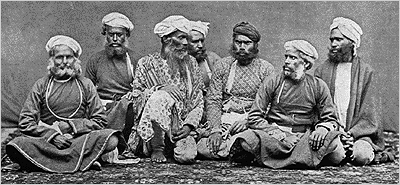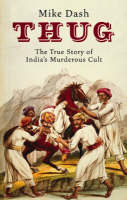The back roads of North India’s mofussil in the first half of the nineteenth century were not a place where you would wish to find yourself alone. Not only had the decline of the once mighty Mughal Empire led to instability, but the region had also suffered from the wars between the Marathas and the British East India Company. Poorly maintained, the roads were the haunts of dacoits (robbers) and wild animals.
Yet every year, once the monsoon rains had passed, many were forced to traverse these lonesome highways. Merchants and farmers left their homes to trade in nearby villages. Others departed to undertake pilgrimages to a distant shrines. Sepoys, who had spent the rainy season on leave, would hasten to return to their barracks.
Many never returned home. Having vanished without a trace, their families would spend the rest of their lives wondering what had happened to their loved ones.
John Cracroft Wilson
There are seven witnesses to his good character, and did I not know the loose manner in which all depositions are taken in almost every court...I should be inclined to think him an innocent man.
So wrote John Cracroft Wilson when faced with a prisoner who, by all appearances, seemed an ordinary man. Decades later, while living out his retirement by farming the land which would later become the Christchurch suburb of Cashmere, it is possible that he often reflected on such encounters. For unlike many of his social peers in colonial Christchurch, he had started his career by assisting in the eradication of a murderous practice which had brought misery and devastation to untold Indian families.
John Cracroft Wilson was born in Madras Presidency, India, in 1802. The son of a British judge, Alexander Wilson, and his wife, Elizabeth, he was later sent to England for his education. There he was schooled at the East India Company College at Haileybury where he would have learned the skills required for a colonial servant in India. In 1826 he furthered his education at Brasenose College, Oxford. He does not appear to have completed his studies, for two years later he married Elizabeth Wall.
Following this he returned to India where he entered into the Bengal Civil Service. It was in this capacity that he was eventually appointed as assistant commissioner to William Sleeman (1788-1856), the district officer in Jubbulpore, and, as a result, drawn into the sinister world of thuggee.
Thug life
Throughout history, the threat of being attacked by bandits has often led to travellers joining together for protection. In India it was no different. Upon arriving at rest houses, travellers would seek out the company of those whose destination also lay along their route. Most often such unions resulted in the traveller safely reaching their journey’s end.
But for the unlucky few, they were marked for death the moment they accepted the offer to join a company of travellers. Confident that there was safety in numbers, they would spend weeks, sometimes even months, sharing the hardships of the road with their newly found companions.
To the unassuming traveller there was nothing extraordinary about their companions. Hindu or Muslim, they appeared no different from the usual farmers, merchants or priests that one might encounter on the road. Yet these men were in fact, thugs, practitioners of a particular form of highway murder known as thuggee.
Thugs differed from regular bandits in that they followed a strict code which regulated how the murder was to be carried out. Thugs would always lure their victim into a false sense of security and then, at a prearranged moment, strangle the victim with a cord. The body was then either buried or disposed of in a well. Anyone could be a victim: man, woman or child, Hindu or Muslim - they did not discriminate.

Hunting the stranglers
In 1830, it was the regular discovery of these bodies that caused William Sleeman to realise that something more than random highway murder was taking place. He saw these unsolved murders as a chance to raise his profile in the eyes of his superiors. Through methodical investigation, interrogation and meticulous record keeping, he created a policing system that was effective enough to track down the gangs of thugs which were operating in or, at the edge of, British territory in India.
In 1832 Sleeman put Cracroft Wilson in charge of operations in the doab region and made him his representative at Etwah. The role required Cracroft Wilson to carefully investigate those men who were brought before him on charges of thuggee, especially since those who were accused often appeared to be respectable family men and contributing members of society.
Those thugs who were found guilty of murder were summarily executed, while others were transported to the Andaman Islands. Some turned against their fellow thugs by becoming informers. In return for assisting British officials in tracking down their former colleagues, these men escaped the death penalty but would spend the remainder of their lives in prison.
Although they found the crimes of these reformed thugs abhorrent, working in such close capacity with the informers, and recognising that they behaved no different than ordinary men in their daily lives, caused some British officials to develop a strange sense of respect for the former thugs. Cracroft Wilson even commented that one of his informers, Makeen Lodhee, was “one of the best men I have known!”’

It was the publication of Sleeman’s report on these criminals and their methods which led to thuggee entering the Western imagination. The thugs were portrayed as a highly organised secret cult, fanatical worshippers of the Hindu goddess Kālī, to whom they sacrificed their victims. Post-colonial scholarship has sought to undo some of these misconceptions but they still remain, as can be found in the ridiculous portrayal of thuggee in the film Indiana Jones and the Temple of Doom. However, Sleeman’s work on thuggee remains with us today in that the ruthlessness and lack of remorse which these criminals possessed caused the word thug to enter the English language.
By 1840 Sleeman was able to proclaim that thuggee had been removed from Indian society.
John Cracroft Wilson continued to work as a magistrate before taking leave in 1854 to visit Australia and then New Zealand, where he purchased land which would later become the suburb of Cashmere. He would later settle permanently in Christchurch, accompanied by his Indian servants, for whom he built Old Stone House.
Cracroft Wilson was certainly a man with personality flaws. Many in colonial Christchurch considered him to be rude, abrupt, and arrogant. Yet his role in the eradication of thuggee, and thus bringing to justice those men who murdered without any regard for their victims, should not be overlooked.





Add a comment to: The Thug hunter of Cashmere